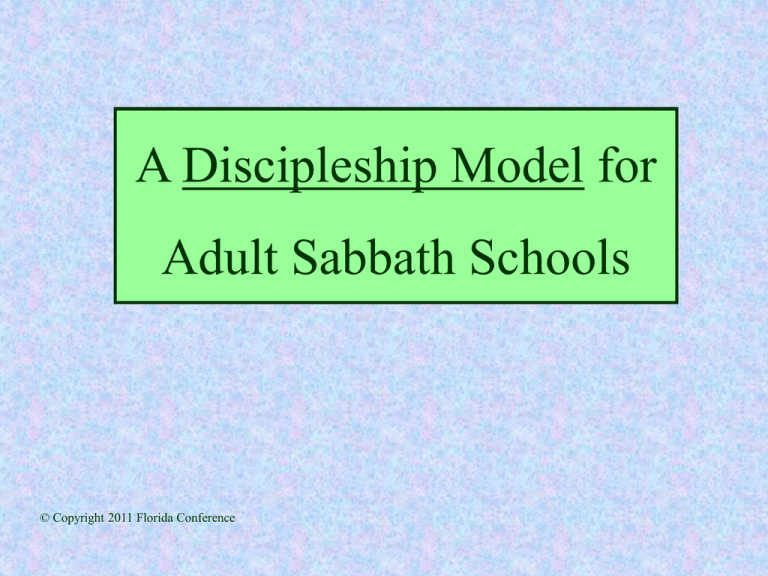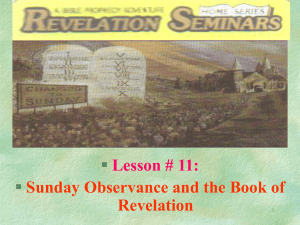A Discipleship Model for Adult Sabbath School
advertisement

A Discipleship Model for Adult Sabbath Schools © Copyright 2011 Florida Conference From Florida Conference Conrad Duncan – Director of Sabbath School and Community Services Kim Johnson – Director of Curriculum Resources To view or download today’s PowerPoint go to: http://www.floridaconference.com/sabbathschool/ Click on “A Discipleship Model for Adult Sabbath School” The ultimate goal: To make adult Sabbath School such a dynamic, life-changing place that attendance is larger than at the Worship Service. We need to overcome the mental image of Sabbath School as the little sister to the Worship Service Organized properly, adult Sabbath School can be the most effective discipleship program of the local church! The problem is that nationally most adult Sabbath Schools are struggling. Increasing numbers of members only come to the Worship Service. Do not attract nearly enough members in their 20’s, 30’s, and 40’s. Very few non-SDA’s attend from the community. Adult Sabbath School “The Sabbath School, when rightly managed, possesses marvelous power, and is adapted to doing a great work, but it is not now what it may and should be.” EGW, CSSW 9 Ellen White issued a stirring call for us to create vibrant adult Sabbath Schools that are overflowing with people. Sadly, across N. America, they are only living up to a small fraction of their potential. What can be done? First, Adult Sabbath School needs to correctly answer the key question: What business are you in? “We’re in the railroad business.” “We’re in the record making business.” What business is your Church in? The church service business? The Sabbath School business? The Revelation Seminar business? The health seminar business? The Vacation Bible School business? Jesus said that our real business is: Making Disciples! “Go therefore and make disciples of all the nations, baptizing them in the name of the Father and of the Son and of the Holy Spirit, teaching them to observe all that I have commanded you.” (Mt 28: 18-20) “Neither going, baptizing, nor teaching are ends in themselves; they are all means to the end of discipling. . . We hear a great deal about baptizing. We talk about teaching true Bible doctrines. Neither of these activities is an ultimate end of the gospel commission.” Cont’d “Jesus said the church’s business is making disciples. To make disciples, we need to go, we need to baptize, we need to teach. But these are not our primary business. If these become ends in themselves, if we ever concentrate on any of them rather than on making disciples, we’ll soon be out of business.” (Floyd Bresee, General Conference Ministerial Secretary, Ministry Magazine, April 1990) ETHAN ALLEN FURNITURE FACTORY Forest Like an Ethan Allen Furniture factory, Sabbath School is supposed to produce something. New Believers Adult Sabbath School “Go into all the world and MAKE DISCIPLES” Maturing Disciples Russell Burrill commenting on Jesus’ Great Commission: “Jesus commanded the church to produce disciples, and that is what obedient churches should be doing.” Recovering an Adventist Approach to the Life & Mission of the Local Church, p. 26. Sabbath School is supposed to be a “People Garden.” All kinds of people growing in all kinds of ways to reflect the love of Christ. 1-21-09 That means that our primary focus needs to be on PEOPLE. Not on methods Not on teaching tools Not on my particular preferences Not on preserving the past Disciple-making requires that we target the whole person. The focus needs to be not only on the spiritual, but on the mental, emotional, social, and physical as well. They are all linked together. What can be done? 1. Know what business Sabbath School should be in – Making Disciples and growing people. What can be done? 1. Know what business Sabbath School should be in – Making Disciples and growing people. 2. We also need to recognize that society has changed dramatically over the last 80 years. There has been a dramatic shift in Generational Attitudes Born before 1940 There has been a dramatic shift in Generational Attitudes Born before 1940 There has been a dramatic shift in Generational Attitudes Born before 1940 – Loyalty to institutions The U.S. Government Out of the Great Depression Won World War II Gave them the New Deal Prosperity in the Suburbs There has been a dramatic shift in Generational Attitudes Born before 1940 – Loyalty to institutions My Dad “A Chevy man” Cape Cod Bank & Trust There has been a dramatic shift in Generational Attitudes Born before 1940 – Loyalty to institutions They come to Sabbath School because that is where they are supposed to be on Saturday morning, regardless of how irrelevant or boring the program may be. That is what the institution (the church) says they should be doing. There has been a dramatic shift in Generational Attitudes Born after WWII The Baby Boomer Generation (1946-1964) Generation X (1965-1980) Generation Y/Millennial (1981-present) There has been a dramatic shift in Generational Attitudes Born after WWII – Loyalty to value The U.S. Government The tragedy of Vietnam Watergate High debt and wasteful spending There has been a dramatic shift in Generational Attitudes Born after WWII – Loyalty to value Me Purchase car with the best value Invest in bank with the best interest There has been a dramatic shift in Generational Attitudes Born after WWII – Loyalty to value They only come to Sabbath School if they perceive it to be valuable. If it is not relevant and interesting, they will not waste their time, regardless of what the institution says. The Key Change In Perspective Adult Sabbath Schools that are stagnant or declining usually have leaders who identify only with the institutional loyalty mindset and refuse to adapt. These leaders say: “If people aren’t attending, it’s their problem. They ought to be here. They must not be committed, spiritual, etc.” The Key Change In Perspective Adult Sabbath Schools that are growing and vibrant have leaders who understand the dramatic generational changes that have occurred and adapt. These leaders say: “If people aren’t attending, it’s our problem. What we are doing isn’t relevant or interesting enough for them to feel it is valuable and worthwhile.” If they are not attending Sabbath School: “Its’ THEIR problem” “Its’ OUR problem” Born before 1940 – Loyalty to institutions Born after WWII – Loyalty to value The worse thing is for these two groups to fight against one another. The best thing we can do is to understand one another, put personal preference aside, and do what is needed to make Sabbath School a success. Like it or not, in today’s world the only choice the church has is to: “Change or die.” Not our doctrines, but our methods. Many people fear change and resist it. But our own comfort cannot dictate what we do. We must be governed by God’s will and purposes. The seven last words of the Church “We never did it that way before.” “The no change” Church 1950 - 2011 To revive Sabbath School we have to think outside the box! Change can be unsettling, but it can also be positive and beautiful. Healthy change honors the past, retains what is still working, and builds on that to get us to a better, more effective place. Also, remember that Jesus was the greatest Change Agent the world has ever seen! What can be done? 1. Understand that Sabbath School is in the business of Making Disciples and growing people. 2. We also need to recognize that society has changed dramatically over the last 80 years, and so must the church in order to be relevant and effective. What specific changes are needed? We are suggesting that your leadership carefully consider how many of the following eight items it is going to embrace in order to enhance Sabbath School. As you think about change, remember to start small and go slowly. From all that you will hear today, think in terms of finding one or two ideas that you can take home and implement. Don’t try to do everything at once. Also remember the change principle that it is better to add than to subtract. + - GOOD DANGEROUS Better to add to Sabbath School than to subtract from what is already there. What specific changes are needed? Learning Environment Staring at the backs of heads. Trying to hear what the person in the pew in front of you saying. A healthy learning environment is critical. It sends a very powerful message about how much or how little we actually value adult education and relationships. The learning environment needs to be: Quiet. Free from distraction. Easily accessible. Ways to create good adult learning environments Movable partitions in the Sanctuary. Movable dividers in the Fellowship Hall. Unused spaces – pastor’s study, kitchen, Mothers Room, etc. Use the Church School if you have one. Use a nearby building if it is closed on Saturday. Modular Units or eventual addition to building The bottom line is to treat the creation of effective adult learning environments as essential and not optional. It is as essential to learning as the Sanctuary is to worship. 1. Learning Environment Teacher Training Teachers need to learn how to: Create excellent discussion questions. Keep the discussion focused. Deal with people who talk too much Involve more people in the discussion. Apply the lessons to everyday life. Build increased trust and openness. Get people to study more. 1. Learning Environment 2. Teacher Training Focus on Information and Relationships in a smaller setting. Bible Study Relation -ships Bible Study We’ve gotten so used to having adult Sabbath School in the Sanctuary, we think that looking at the backs of heads, not relating to one another, and having a hard time hearing each other is the only option. Small groups have proven to be a great alternative. In Small Groups people build both knowledge and relationships in a non-judgmental atmosphere. Russell Burrill comments: “It is God’s plan and Jesus’ desire that Christians grow in small groups. The purpose of small groups is not just meeting to study the Bible. The purpose of groups is to give Christians a place where they can grow together.” The Revolutionized Church of the 21st Century, p. 54 Ellen White’s perspective on small groups: “To Ellen White, small groups were not just a program of the church, they were the major organizing principle of the work of the church. To have a church without small groups operating in it was anathema to Ellen White, for the church is to be built on small groups.” The Revolutionized Church of the 21st Century, p. 137 Trinity Life Church Life Trinity Life Oneness Church Life Trinity Life Community Church Life The supreme test of discipleship: Not how much we know Not how often we go to church Not how much we tithe Not how active we are in the church Jesus said, its’ how much we love each other “By this shall all men know that you are my disciples, if you have love for one another.” Jn 13:35 Relationships are formed best in a small group setting. Sabbath School is a wonderful place for Adventists to experience small groups for the very first time. Sabbath School also becomes the “springboard” for small groups that meet during the other days of the week Meeting in small groups during Sabbath School Sun Mon Tues Wed Thurs Fri 1. Learning Environment 2. Teacher Training 3. Focus on Information and Relationships in Small Groups Service Opportunities Foreward to “Counsels on Sabbath School Work” written by the General Conference Sabbath School Department in 2002: “From [Ellen White’s] counsels four chief purposes have been developed for the world Seventh-day Adventist Sabbath School system: (1) study of the Word, (2) fellowship, (3) community outreach, and (4) world mission emphasis.” Bible Study Relation -ships Bible Study Relation -ships Service A disciple-making Sabbath School needs to balance two important emphasis: Outreach Nurture Nurture without Outreach results in stagnation and little growth. And Outreach without Nurture results in people dropping out. They must be in balance Outreach Nurture The service projects are not done AFTER Sabbath School, but DURING Sabbath School. That way Sabbath School itself becomes mission oriented and you get a lot more people involved in outreach. Member Participation 100 Organized Service Opportunities 20 Sabbath Morning Sabbath Afternoon 10 Sunday 5 Midweek Plan 1: Dedicate 15 minutes of Sabbath School time in the group each week to service. For example: Everyone bring their cell phone and call one shut-in or person in the hospital. Collect shaving supplies each week and give to Homeless Shelter at the end of the month. Create festive wrapping. Class members collect change in jars at home. Bring to class after a few weeks and use money to purchase a gift for a needy, hurting person. Have everyone bring in fresh fruit to make a fruit basket. The group decides who to give it to. It need not be a shutin, but anyone who needs encouragement. Plan 1: Dedicate 15 minutes of Sabbath School time in the group each week to service. For example: (cont’d) Everyone bring a few fresh flowers that are picked or purchased to make a bouquet to bring to someone who could use some encouragement. Have each class member purchase a card for someone the group decided on the week before. Bring the cards to the class, write a short note of blessing and appreciation, and everyone sign each card. Mail them at the same time. Fill out postcard size “Encouragement Cards” or “Appreciation Cards” with the person’s name on the front. Give it to the church office to add the address and mail. Plan 2: Periodically devote all of the Sabbath School group time to service, staying within the building. For example: The class members practice a skit to be presented during the church service, children’s Sabbath School, or some other time. Choose skits that are designed to involve a dozen or more people. Skits can be purchased online from places such as: http://www.crosspointscripts.com/site.cfm/home.cfm http://www.willowcreek.com/servicebuilder/catalog.asp?catId=2 Get white poster board that is 3 feet on each side. With a pencil divide it into 12” by 12” squares. Decide on one overall scene and have members color in only the portion in their square with crayons. Cut out and send one square per day to the person you want to uplift so they can put it all together. Include a note that it is a puzzle. Plan 2: Periodically devote all of the Sabbath School group time to service, staying within the building. For example: Assemble kits for the Homeless – “Street Corner Care Kit” ½ gallon freezer bag Food Drink Socks Hand cream Toothbrush etc Plan 3: Periodically devote one entire Sabbath morning to service out in the community using a van or bus. Make the theme Random Acts of Kindness. For example: Go online ahead of time and purchase balloons that you can have the company put a Christian message on. Take a rented helium tank to a downtown park, fill the balloons with helium, and give them away to families. If they ask why you are doing this just say, “To demonstrate God’s love.” Purchase cold soft drinks or water ahead of time and have the class give them away to cars that stop at red lights. Plan 3: Periodically devote one entire Sabbath morning to service out in the community using a van or bus. Make the theme Random Acts of Kindness. For example: (cont’d) Florida Hospital Church offered eleven service opportunities during regular Sabbath School. Sign up ahead of time. Both within the church and community. For other ideas see websites such as: http://www.helpothers.org/ideas.php Put “Random Acts of Kindness ideas” in a Google search. Plan 1: Dedicate 15 minutes of group time each week to service. Plan 2: Periodically devote all of the Sabbath School class time to service, staying within the building. Plan 3: Periodically devote one entire Sabbath morning to service out in the community using a van or bus. Sabbath School becomes the “springboard” for ministries to occur during the other days of week Service to NonSDA’s during Sabbath School Sun Mon Tues Wed Thurs Fri 1. Learning Environment 2. Teacher Training 3. Focus on Information and Relationships in Small Groups 4. Service Opportunities Need-based Alternatives The adult Sabbath School Quarterly has been a great blessing to many people over the years. We believe in using the Quarterly and we promote it. Those who teach it should certainly be honored. Strengths of the Quarterly Bible based Extensive use of Spirit of Prophecy Provides many spiritual insights Content comes from broad input Used throughout the denomination Problems that must be faced Classes that study the Quarterly are not well-suited for non-SDA’s The issue is that non-SDA’s are beginners among long-time Bible students. They also have a hard time relating to the “SDA lingo” from members. Ellen White in class Our usual approach is to isolate non-SDA visitors. We say, “They need their own class because they’re not ready to study the Quarterly yet.” The best answer is to invite people from the community into a variety of alternative Sabbath School groups that are designed to meet them at the point of their need. The groups are made up of members and their non-SDA friends and acquaintances. Possibilities for Alternative Sabbath School Classes Various Bible Study Topics Marriage & Family Spiritual Health Physical Health Mental Health Emotional Health Nature Court mandated attendance at an anger management classes. Social agency required classes on parenting. Curriculum for 3rd Quarter AUG JULY TOPIC WHERE MEETS # Wks Quarterly Sanctuary 13 Quarterly Room 103 13 Quarterly Fellowship Hall 13 Spiritual Gifts Fellowship Hall 8 Grief Recovery Mother’s Room 7 Overcoming Stress Pastor’s Study 5 Prayer Kitchen 5 Raising Great Kids Fellowship Hall 4 4 11 18 25 1 8 15 SEPT 22 29 5 12 19 26 Why Sabbath Morning for Non-SDA’s in small groups? 1. Convenience for them. Not tired after work. 2. Able to mingle with many more SDA’s. “Why are all of these people here?” 3. Free spiritual programs and activities for children. 4. Easier to get them to come to the Worship Service. 5. We reach the entire family. 6. Highly relational setting instead of lectures. Why Sabbath Morning for Non-SDA’s small groups? 7. Much easier to get SDA volunteers. 8. Benefits our own adults and children being around Non-SDA’s. Creates a mission mentality. 9. Teachers become more evangelistic in attitude. 10. Fulfills EGW’s dream of Sabbath School being a major soul winning agency. Sabbath Schools With Alternative Classes: Sabbath morning groups and classes attended by members and their friends from the community: “Forgive to Live” seminar. 85 in attendance with 65% from the community. 8 Sabbath mornings. Sabbath School Service Tasks Alternative Classes Non-SDA’s in the community “The object of Sabbath School work should be the ingathering of souls.” EGW, CSSW 61 “The Sabbath school should be one of the greatest instrumentalities, and the most effectual, in bringing souls to Christ.” EGW, CSSW 10 Problems that must be faced Many of our adults ages 20-40 are not attracted to the Quarterly. We know they want value. They also want choice. We live in a world of choices and options. For example, when McDonald’s opened in the early 1960’s it offered only burgers, fries and milkshakes. What about today? Fruit and Maple Oatmeal Fruit and Walnut Salad Steak and Eggs Pancakes McRibs Angus Wraps Filet-OFish Caesar Salad Smoothies Chipolte BBQ Wraps Chicken Salad Lattes Capuccinnos Burritos Honey Mustard Snack Wraps Southwest Salad Why? Because they love us?? Because they want to attract new business and be successful! They know that people demand options. We ignore that lesson at our peril. What does your adult Sabbath School curriculum provide for these people in your town or city? A mother with a critically ill son who wants to know more about prayer. What does your adult Sabbath School curriculum provide for these people in your town or city? A young lady who wants to know about the book of Revelation. What does your adult Sabbath School curriculum provide for these people in your town or city? A couple in their mid-30’s whose marriage has a lot of unresolved conflict. What does your adult Sabbath School curriculum provide for these people in your town or city? A single mom with two kids who just lost her job and wonders how she can make the mortgage payments. What does your adult Sabbath School curriculum provide for these people in your town or city? A wife whose husband just died in a tragic car crash. What does your adult Sabbath School curriculum provide for these people in your town or city? A man in his 40’s whose doctor told him he has to lower his stress level now in order to get his blood pressure under control. What does your adult Sabbath School curriculum provide for these people in your town or city? A couple in their early 20’s who are unable to control their two children. It is putting huge stress on their marriage. What does your adult Sabbath School curriculum provide for these people in your town or city? A lady who is struggling with depression and anxiety. Offer one or two alternative subjects then build from there as needed. Not everything you offer needs to last thirteen weeks. 1. Learning Environment 2. Teacher Training 3. Focus on Information and Relationships in Small Groups 4. Service Opportunities 5. Need-based Alternatives New name for alternative classes. SABBATH SCHOOL Non-SDA’s haven’t learned about Sabbath yet. School makes them picture homework, lectures, and tests. Traditional Sabbath School Life Enrichment Center LIFE ENRICHMENT CENTER You can keep the traditional Sabbath School and develop the Life Enrichment Center as an ongoing alternative. The name Life Enrichment Center should provide an excellent opportunity to invite non-SDA’s: “This group meeting is being held at the Life Enrichment Center in my church” vs “My church is offering this meeting.” 1. Learning Environment 2. Teacher Training 3. Focus on Information and Relationships in Small Groups 4. Service Opportunities 5. Need-based Alternatives 6. New Name for alternative classes Rethink Preliminaries Those who have put together programs over the years for the Sabbath School Preliminaries should be thanked and honored for their many hours of dedicated work. We do, however, need to recognize that members who consistently arrive late or at the end of the Preliminaries are “voting with their feet” that it is not relevant for them. The answer is to not expect everyone to attend the Preliminaries. Make them available for those who want them or eliminate them altogether if there is a consensus to do so. Start some small groups at the same time as preliminaries for those who want to have more time. Everyone could still be invited to gather together periodically for Mission emphasis. 1. Learning Environment 2. Teacher Training 3. Focus on Information and Relationships in Small Groups 4. Service Opportunities 5. Need-based Alternatives 6. New Name for alternative classes 7. Rethink Preliminaries Various lengths of time Time T i m e 10:30 Adult Sabbath School Babysitting 9:00 1. Learning Environment 2. Teacher Training 3. Focus on Information and Relationships in Small Groups 4. Service Opportunities 5. Need-based Alternatives 6. Life Enrichment Center 7. Rethink Preliminaries 8. Various lengths of time Don’t be overwhelmed. Don’t go home and try to change everything at once. Select one or two items that you feel have the best chance of success. Move slowly, get support from leadership, and build from there. Every journey begins with one step. With God’s special blessing and our willing hearts, adult Sabbath Schools can once again become vibrant, life-changing places! To view or download today’s PowerPoint go to: http://www.floridaconference.com/sabbathschool/ Click on “A Discipleship Model for Adult Sabbath School” Contact Info: conrad.duncan@floridaconference.com kim.johnson@floridaconference.com THE END Updated 9-7-11









